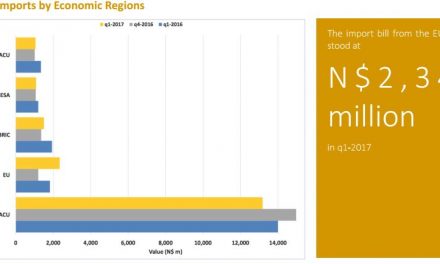
Real interest rate dips into negative territory
Bad news for cash flush companies, pensioners and other fixed income earners as Namibia has been experiencing a negative real interest rates for the past three months.
The negative real interest rate has been caused by the annual inflation rate being greater than the repo rate since December, Capricorn Group Economist John Steytler said.
The repo rate has been unchanged at 6% since December 2010 when the central bank governor, Ipumbu Shiimi cut the repo rate by 75 basis points in a move aimed at boosting growth at a time when inflation was at a five-year low. However, since December 2011 inflation has been hovering above 6%. In December annual inflation reached a two-and-half year high of 7.2% and January saw annual inflation at 6.6% while February inflation was recorded at a 32-month peak at 7.4%.
Steytler believes the country will continue to experience negative real interest rates, at least in the short term. He said: “Currently this looks unlikely to change, as we do not foresee an increase in interest rates in the first half of 2012, and are expecting internal demand pull and external cost push inflation to continue over the coming months.”
Due to the negative real interest rates currently prevailing, Steytler says there is limited financial incentive for depositors to save and a great incentive for borrowers as seen by the growth in credit extension.
Growth in private sector credit moved from 9.8% in December to 11.2% in January although the growth abated slightly in February to 10.2%. The decline in PSC growth in February was largely attributed to a reduction in overdraft extension, both to business and individuals.
The slight decline in growth of credit to businesses was, according to the Central Bank, driven by the repayment of overdrafts by two of the country’s major corporations.
However, credit to companies increased from N$14.9 billion in February 2011, to N$16.4 billion in February 2012. The majority of this increase in business credit extension was driven by increases in mortgage loans (which increased by N$1.3 billion over this one year period).
As with business credit extension growth, growth in credit extension to individuals fell slightly in February compared to January, from 10.9% to 10.3%. The main contributors to this decline in growth came from a slight contraction in overdraft lending (of 0.6%) and a slowing in growth of “other loans and advances” from 4.9 to 4.7%. The “other loans and advances” category includes personal loans and credit cards amongst others.
Mortgage lending makes up the largest component of total loans advanced. After reaching an annual high in December 2011 of 15.6% growth, mortgage lending growth slowed slightly in January to 14.7% and again in February to 14.0%. Both slight reductions in growth were predominantly due to slight reductions in mortgage credit extension to individuals.
The current rate of growth remains extremely high compared to past years. Mortgage loans now total N$23.9 billion, of which N$5.1 billion is business mortgages and N$18.8 billion is mortgage loans to individuals. In February 2011, total mortgage loans were just below N$21 billion.
Annual growth in installment sales increased significantly in February, to 18.8% from 16.8% in January. This credit growth has been driven by both business and individual credit extension, and the increased growth was also distributed between both business and individuals.
The current level of growth is well above the average level seen in 2011 (13.2%). The increase in growth in installment sales was expected due to the dramatic increase seen in purchase of vehicles over recent months, as well as growth in demand for other durable, interest sensitive goods and services. Vehicle sales in January totaled 1582, while in February an increase of nearly 24% was seen, resulting in an increase to 1958 vehicles sold.
Said Steytler: “We have little doubt that the Central Bank will be closely monitoring the increases in business debt levels and household indebtedness, and believe that increases in debt may play a role in determining the right time for fiscal tightening. This said, we reiterate that we do not believe tightening will occur any time in the next quarter at least.”












































